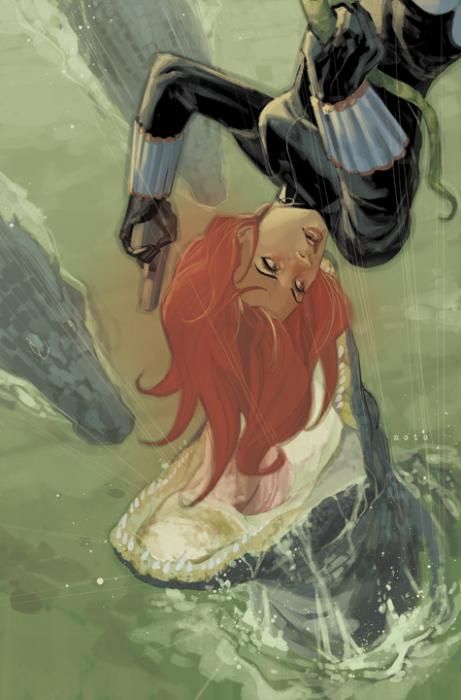Nathan Edmondson and Phil Noto's "Black Widow" #3 finds Natasha making a grave error, one she has to correct with extreme violence and death. Despite protocols and procedure Natasha takes a job rescuing the wrong man from a prison in Argentina and the way to rectify it involves jumping out of helicopters, knifing people in rivers and avoiding man-eating crocodiles. Good times all around!
Particularly strong about this third issue is Edmondson's willingness to let Natasha screw up. In the first two issues, readers were presented with a nearly flawless Natasha when it came to her work, which felt right. Natasha is nothing if not capable -- she's nigh-on unkillable, a legend not unlike Wolverine when it comes to survival. However, it's not interesting to read about perfect characters that don't screw up. Even brilliant superhero assassin types have to be wrong sometimes, and at just the right time (after establishing her as the utter badass most of us already know she is and after new readers have had a chance to figure it out), Edmondson lets Black Widow make a mistake -- a big one. It's the kind of mistake that gets people killed or, more to the point, means she has to kill people in order to set things right.
At the same time, Edmondson has gone to good lengths to establish Natasha's personal boundaries, and allows her to make a potential mistake in her home life as well. After making a mistake while on the job, things break at home for Natasha and she gets involved in her neighbor's life in a way you can feel is abhorrent to her, but which she can no longer tolerate ignoring. It's not necessarily the subtlest of turns, but it all works well. On the whole, these are good smart moves helping to solidify Edmonson as a writer that can well handle Natasha and her many layers.
Noto continues to establish himself as "the" artist for Natasha as he effortlessly moves from the quiet, loaded, emotional moments to high-octane action. This issue finds Noto a bit looser in places, which is not necessarily a bad thing. It frequently works in his favor, like in a dark exterior jungle scene, which looks sharper and feels more dangerous than the rest of the book, and feels soft and atmospheric in comparison. However, what Noto continues to do best are the subtle nuances of Natasha's face and body language. This kind of skill is vital for the series artist, partially because of Natasha's naturally laconic nature, and partially because it allows Edmondson to rely more on the silence that comes with being a spy. Noto can do it all with the simplest twitch in a facial expression. The moment when Natasha realizes her mistake in the helicopter is absolute perfection. It's the kind of simple and flawless moment that every artist should aim for.
"Black Widow" continues to prove itself as a finely constructed, utterly engaging comic that's free of heavy continuity -- at least so far. It's exactly the kind of beautiful book Natasha deserves, and let's hope it can keep on this steady and impressive roll.

